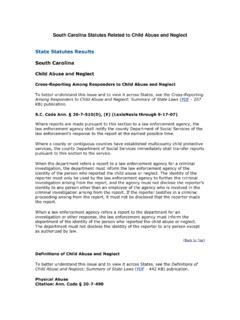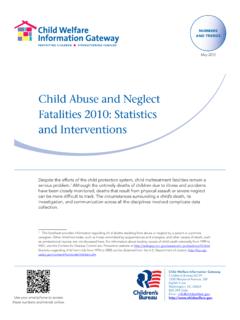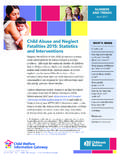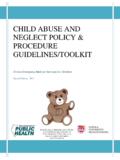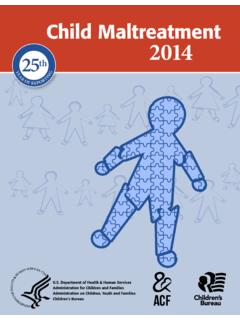Transcription of Why We Remove Kids - Action For Child Protection
1 Why We Remove kids Introduction A long time ago when our Executive Director managed a county Child Protective Services (CPS) agency a community group decided that a survey about the quality of the agency s services was needed. The survey had an interesting finding: of the respondents believed that the CPS agency removed too many children; of the respondents believed that the CPS agency did not Remove children enough. Hmmm. Wonder what the truth was? CPS agencies get a lot of grief over the question of whether to Remove a Child from his or her home or not.
2 CPS agencies are criticized for disproportionality with respect to Child removal. Critics observe that agencies Remove higher percentages of minority children in particular African American children in comparison to minority populations within communities. When fatalities occur, community advocates say CPS should Remove more children, and as a result often placement rates go up. Upon occasion, observers of CPS decision making state that Child removal decisions are biased or often associated with worker values, workload, lack of resources, uncooperative clients, and so on.
3 It s correct to acknowledge that criticism of the effectiveness of decision making and practice in this extremely serious area of CPS work is at times warranted. In fact it is imperative that those of us in the CPS profession continue to always be vigilant about actions we are taking which interfere with family life and parental authority. So, this month we are taking a look at this question of Child removal as a dimension of safety intervention decision making and practice. We will use another article to stimulate the consideration. Paul Chill wrote an excellent article, Burden of Proof Begone: The Pernicious Effect of Removal in Child Protective Services, for the Family Court Review (Volume 41, October Action for Child Protection , Inc.)
4 Page 1 April 2009 2003.) We will summarize some key points Mr. Chill made in his article prior to providing observations about removal as a safety intervention. We encourage you to read Chill s powerful article and share it with your attorneys and judges (just in case they ve not read it). The Pernicious Effect of Removal in Child Protective Services The author begins in his article and throughout to emphasize the significant negative effect removal has on children, families, and parents. Chill correctly explains how removal launches a process which can literally spin out of control in terms of reuniting a family.
5 It is pointed out that questionable and sometimes increasing Child removals occur despite law which requires this option being seldom used. Chill points out as we have in previous articles concern with CPS intervention which fails to respect the Constitution which assures parents, children families a right to be free from unwarranted government intrusion. With respect to that right, courts have held that only an imminent danger to a Child 's life or health can justify interfering in family life resulting in the removal of a Child without notice and a court hearing first.
6 Chill agrees that increases in the use of emergency removal might be justified if it were necessary to protect children from imminent danger. He observes, however, statistics published by the Department of Health and Human Services 2001 indicated that one in three who was removed was found not to have been maltreated. Chill s point is that the standard for removal imminent danger is not applied in 2/3 of the decisions. The author concludes that statutory definitions of maltreatment contribute to the mistakes occurring in deciding to Remove children.
7 He states, Because definitions of maltreatment are extremely broad and substantiation standards low, it can be reasonably assumed that a significant number of other children who are found maltreated, and for whom perhaps some intervention--short of removal--is warranted, are nonetheless removed on an emergency basis. Action for Child Protection , Inc. Page 2 April 2009 Chill believes that a major influence of this tendency to Remove is "defensive Social Work." This refers to practice and decision making in CPS that is fear driven. The idea is that CPS workers (and perhaps supervisors and managers also) lean toward removing children out of fear of what might happen if they didn t.
8 This includes the CYA mentality related to civil and criminal liability, threat of personnel actions, and/or bad PR. Chill mentions the mentality of staff and agency leaders operating and justifying their actions and decision as "erring on the side of safety." Most of Chill s article is devoted to what he calls the snow ball effect that occurs in the legal process once a Child is removed. He correctly points out that the focus of court proceedings (and we might add continuing CPS intervention) changes from the criteria on which a removal is justified to different criteria for whether and when a Child should be returned.
9 He says, The burden of proof shifts, in effect, if not in law, from the state to the parents. In his article, the author reinforces our own experience that once children are removed they remain in CPS custody a long time. This should not happen. Chill discusses the way it is supposed to work. He describes the two-step legal process with which you are likely familiar: (1) the adjudicatory phase which determines whether a Child has been maltreated and (2) the disposition phase which determines what remedy is indicated. Chill believes the emergency removal serves as an end-run around the adjudicatory and dispositional phases, effectively predetermining their outcome and depriving them of their intended purposes.
10 In part, he suggests this happens as much from personal predispositions as anything else. Here we conclude the meaning to be that once the process starts actors in the process ( , CPS staff, lawyers, judges) they go along with the assumption that a Child is in imminent danger rather than taking an alternative view including requiring rigorous justification. Chill points out that reunifying a Child following emergency removal is more likely to occur if done so at the initial court hearing ( , detention hearing occurring within 24 to 72 hours following removal depending on a state s law).

